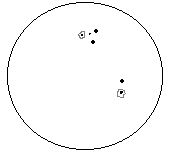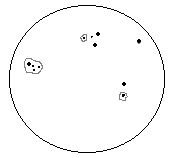|
A nice way to increase your telescope time is with the addition of a solar filter. For some reason clear days always seem to be more abundant than clear nights and, with such a bright target, you don’t need perfect conditions for useful observations. While any size of scope will do, my preference for filter material is Baader solar film. This can be bought quite inexpensively as a sheet, then cut and mounted into a cardboard cell. Or, if you’re all thumbs like me, for a bit more money you can purchase a Kendrick ready–made unit in an aluminum cell. You won’t see solar flares or the boiling surface of the Sun with this type of filter, but you do get a nice white image with the subtle shading of faculae and sharp definition of the sunspots. Now I feel somewhat obligated to state the obvious here, so: solar viewing should only be done through optics that have approved filters covering the objectives, and finderscopes should be removed or capped. A sunspot consists of an “umbra”; a dark core that can range in size from a small speck to a fair-sized blemish, and this is occasionally surrounded by a halo called the “penumbra”. Often, finely structured lines similar to bicycle spokes can be seen throughout the penumbra. Appearing singly, or in groups, spots can last for hours, days or weeks. At first, the simple joy of seeing these features is entertainment in itself but, eventually, you’ll want to make a sketch. In fact, several sketches on consecutive days will show how the spots change and demonstrate the rotation of the Sun. Once you’ve done that the next logical step is a Zurich-Wolf sunspot count - a fairly easy method of rating solar activity. Johann Rudolf Wolf (1816-1893) was a Swiss mathematician and professor of astronomy. In 1855, he accepted a Chair of astronomy in Zurich and was instrumental in the opening of Zurich Observatory on 1864. Although heavily into probabilities, prime number theory and geometry Wolf is best remembered for his work on the 11 year sunspot cycle - a regular period of activity that takes about 4.5 years to go from minimum to maximum and about 6.5 years to recede from maximum back to minimum. Wolf’s proposition that sunspot activity be calculated through a combined count of groups and individual spots is a method that is still in use today. Essentially, each group (g) represents 10 times the activity of a single spot (f). The Relative Spot Number (RSN) or Zurich/Wolf number as it has been coined is calculated by counting the number of groups and multiplying those by 10, then adding the individual sunspots (even the ones that make up the groups) for a total count. It is important to note that an isolated spot is also considered as a group – so if all you see is a single spot then your RSN will be 11. The formula looks like this: RSN = (g x 10) + f , where f represents the total number of the individual spots. A few examples follow.   
Example 1. . . . . . . . . . . . . Example 2 . . . . . . . . . . . Example 3 Example 1 has three individual spots unrelated to each other.
Example 2 has 2 related groups and 6 individual spots.
Example 3 has 4 groups and 11 individual spots.
If you enter your counts into a simple spreadsheet, over time you should be able to generate a graph to show the rise and fall of the activity. In order to submit your data for scientific use you’ll need to be proficient, and dedicated, but for your own edification you can find a lot of useful information at the AAVSO website: www.aavso.org/observing/programs/solar/ On a somewhat related note, a group of scientists
trying to link outbreaks of influenza with peaks of solar activity found
that the two did coincide. So, depending on the count, you may want to get a
flu-shot. Meanwhile, why
not grab a hat and your SPF 30 and begin your own study of our closest
star because, if nothing else, a natural dose of vitamin D is a great way
to put a smile on your face.
Copyright - Glenn Muller, 2003
|